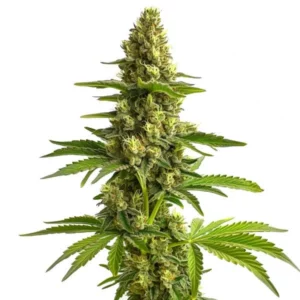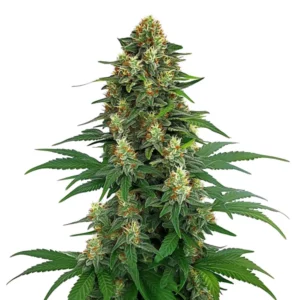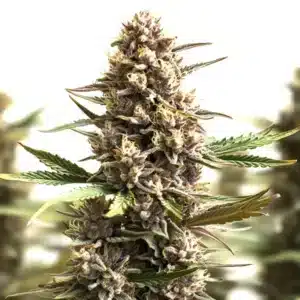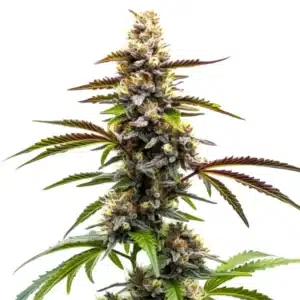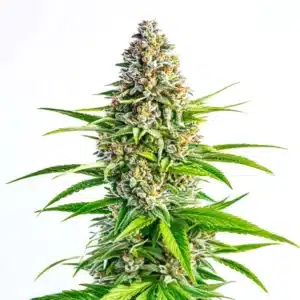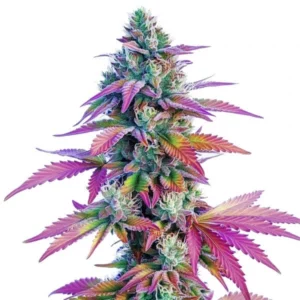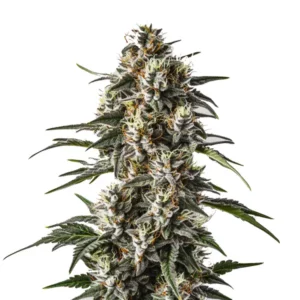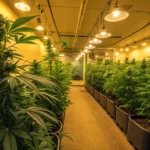
How Light Affects Plant Hormones
When it comes to growing cannabis, light is not just about helping your plants grow. It’s about how light affects plant hormones, which in turn affects growth, flowering, and yield. Light influences which hormones are produced and how much of them are active.
Plant hormones, also known as phytohormones, are chemical messengers that control all aspects of plant growth and development. Light plays a critical role in regulating these hormones. The effects of light spectrum on plant hormones can vary, significantly impacting how your cannabis plants grow.
Recommended Strains
Bruce Banner #3
|
|
THC | 20% - 29% (High) |
|
|
Type | Feminized |
|
|
Yield | Medium |
|
|
Phenotype | 50% Indica / 50% Sativa |
Tangie
|
|
THC | 19% - 22% (Medium) |
|
|
Type | Feminized |
|
|
Yield | High |
|
|
Phenotype | 30% Indica / 70% Sativa |
Whether you’re a first-time cannabis seed buyer or an experienced grower, knowing how light affects plant hormones can help you make informed decisions. You can optimize conditions to get the most out of strains like Blue Dream, Tangie, and Bruce Banner 3 from Blimburn Seeds.
Light Spectrum and Plant Hormones
Different colors of light can have unique effects on plant hormone production. For instance, blue light is essential for producing hormones that regulate plant growth and development. Red light, on the other hand, is crucial for flowering and fruiting.
The effects of light spectrum on plant hormones are particularly important in indoor growing environments. By adjusting the light spectrum, you can influence the balance of hormones like auxins and gibberellins. This can lead to stronger stems and more vibrant leaves. Strains like Tangie from Blimburn Seeds thrive under a well-balanced light spectrum.
Knowing how light influences plant hormone levels can provide growers with a competitive edge. By tailoring light conditions to the specific needs of your plants, you can enhance hormone regulation, leading to more robust growth and improved yields. This knowledge is particularly valuable for optimizing indoor growing setups.
Moreover, the relationship between light exposure and plant hormone activity is a dynamic one. As plants progress through their growth stages, their hormonal needs change, requiring growers to adjust light conditions accordingly. This adaptability is key to maximizing the potential of each cannabis strain, ensuring healthy development and abundant harvests.
Blue Light and Plant Growth
Blue light influences plant hormone levels that control growth. It encourages the production of auxins, which are hormones that promote cell elongation. This is why plants grown under blue light tend to be stockier.
For cannabis growers, using blue light during the vegetative stage can result in short, bushy plants. This is particularly beneficial for strains like Bruce Banner, known for its robust growth and potency.
The role of light in regulating plant hormone balance becomes apparent when utilizing blue light. It not only promotes the formation of stronger, more compact plants but also enhances the development of nutrient-rich foliage. This can lead to improved photosynthesis and overall plant health.
The impact of light intensity on plant hormone production is also evident with blue light. While moderate levels encourage healthy growth, excessive blue light may stress plants, altering hormone levels unfavorably. Thus, careful management of blue light exposure is crucial for achieving optimal growth conditions.
Red Light and Flowering
Red light plays a key role in the flowering stage of cannabis plants. It affects plant hormone activity associated with flowering and fruiting. The right amount of red light can trigger the production of hormones that lead to blooming.
This is crucial for strains like Blue Dream, which require precise light conditions to reach their full potential. Ensuring adequate red light can maximize yields and improve flower quality.
In the context of how light affects plant hormones, red light is indispensable for encouraging the hormonal shifts necessary for flowering. It stimulates the production of florigen, a hormone that promotes bud formation and flowering, crucial for high-yielding crops.
Furthermore, the effects of light spectrum on plant hormones are most visible during the flowering phase. By strategically using red light, growers can ensure their plants undergo the hormonal changes needed for optimal flowering and resin production, boosting both yield and potency.
Promos & Deals
Light Intensity and Hormonal Balance
Light intensity can significantly impact plant hormone production. Too much light can lead to stress, which affects hormone levels. On the flip side, too little light can stunt growth.
The impact of light intensity on plant hormone production is evident in how plants respond to their environment. Adjusting light intensity can help maintain a balance of hormones like cytokinins and abscisic acid, crucial for stress management and growth regulation.
Knowing the function of light in regulating plant hormone balance is essential for successful cultivation. Proper light intensity ensures that hormones are synthesized at optimal levels, supporting healthy growth and stress resilience.
The relationship between light exposure and plant hormone activity underscores the importance of adapting light conditions to meet the evolving needs of plants. By managing light intensity with precision, growers can enhance hormone regulation, leading to healthier, more productive plants.

Managing Light for Optimal Growth
Managing light exposure is crucial for maintaining the right hormonal balance. This involves adjusting both intensity and duration to match the needs of your cannabis strain.
For instance, Blue Dream thrives under moderate light intensity. High light levels can stress the plant, leading to undesirable hormonal changes that can affect yield.
Effective management of light exposure ensures that the effects of light spectrum on plant hormones are beneficial rather than detrimental. By carefully calibrating light settings, growers can promote desirable hormone activity, supporting each growth phase.
Moreover, how light influences plant hormone levels is a key consideration when fine-tuning light exposure. By understanding the relationship between light and hormones, growers can make informed adjustments to their setups, optimizing growth and maximizing yield potential.
Real-Life Examples of Light Management
Experienced growers often use light meters to measure intensity. This helps in making informed adjustments to light setups. For example, using dimmable LED lights allows for easy control of light intensity to suit different stages of growth.
Another practical tip is to gradually increase light intensity as your plants mature. This helps in acclimating them to higher light levels without causing stress.
Real-life examples of how light affects plant hormones can be seen in various cultivation strategies. Growers who monitor and adjust light conditions precisely often report improved plant health and increased yields, demonstrating the importance of light management.
Additionally, the impact of light intensity on plant hormone production is evident in successful grow operations. By employing tools like light meters and dimmable lights, growers can achieve the ideal balance required for maximizing plant potential and enhancing hormonal regulation.

FAQs
What is the relationship between light exposure and plant hormone activity?
Light exposure directly influences plant hormone activity. When plants receive the appropriate light, they produce hormones that regulate growth and flowering. Too much or too little light can disrupt this balance, affecting overall plant health.
For instance, excessive light can lead to stress hormones that impede growth. Conversely, inadequate light can reduce the production of growth-promoting hormones. Striking the right balance is key for strains like Bruce Banner 3, which require specific conditions to thrive.
The relationship between light exposure and plant hormone activity is a critical factor in successful cultivation. By knowing how light affects plant hormones, growers can tailor their setups to enhance hormone production, improving plant vigor and yield.
Furthermore, how light influences plant hormone levels is a dynamic process that evolves with plant development. By continuously adapting light conditions, growers can support optimal hormonal balance, ensuring healthy growth and abundant harvests.
How do different light spectrums affect cannabis growth?
Different light spectrums influence various aspects of cannabis growth through hormonal changes. Blue light promotes vegetative growth by increasing auxin levels, leading to thicker foliage. Red light is crucial during the flowering stage as it enhances the production of flowering hormones.
This knowing allows growers to tailor light setups to the specific needs of their strains. For example, using a combination of blue and red lights during different growth phases can optimize the plant’s hormonal responses, leading to better yields.
The effects of light spectrum on plant hormones are profound, impacting not just growth but also plant health and productivity. By leveraging different spectrums, growers can induce specific hormonal changes, optimizing each stage of plant development.
Moreover, the role of light in regulating plant hormone balance is evident in how different spectrums contribute to overall plant vitality. By experimenting with light combinations, growers can enhance hormone regulation, resulting in stronger, more resilient plants.
Why is light intensity important in cannabis cultivation?
Light intensity is vital because it affects the rate of photosynthesis and hormone production. High intensity can accelerate growth but may also cause stress, leading to the production of stress hormones that can hinder development.
On the other hand, low light intensity can slow down growth and reduce yield. Adjusting light levels to the needs of your cannabis strain is crucial. Strains like Tangie benefit from higher light intensities, which support vigorous growth.
The impact of light intensity on plant hormone production is a pivotal aspect of successful cultivation. Properly managing intensity ensures that plants receive the right amount of light to support healthy hormone levels, promoting robust growth.
Knowing how light affects plant hormones in relation to intensity allows growers to optimize their cultivation practices. By fine-tuning light exposure, they can ensure their plants achieve the ideal hormonal balance needed for maximum yield and quality.
Can artificial light replace sunlight for cannabis growth?
Artificial light can effectively replace sunlight, especially in indoor grows. Modern LED systems can mimic the full spectrum of sunlight, allowing for controlled growth environments. This replicates how light affects plant hormones, promoting healthy growth.
However, it’s essential to monitor light settings closely. Unlike sunlight, artificial light requires precise management to ensure optimal intensity and spectrum. This is crucial for strains like Blue Dream, which need specific conditions to flourish.
When considering how light influences plant hormone levels, artificial light offers unparalleled control over growth conditions. By adjusting both spectrum and intensity, growers can create environments that support ideal hormonal development.
Moreover, the role of light in regulating plant hormone balance is enhanced with artificial setups. By replicating natural conditions, growers can ensure their plants undergo the necessary hormonal changes for healthy development and abundant flowering.
How can I optimize my grow setup for better hormonal regulation?
Optimizing your grow setup involves adjusting both the light spectrum and intensity to match your plants’ needs. Using adjustable LED lights can help you fine-tune these settings as your plants progress through different growth stages.
For example, starting with more blue light during the vegetative stage and transitioning to red light in the flowering stage can enhance hormonal regulation. This approach supports robust growth and maximizes yield, especially for high-performing strains like Bruce Banner.
Knowing how light affects plant hormones is key to optimizing your grow setup. By strategically managing light conditions, you can ensure your plants experience the right hormonal changes at the right times, maximizing growth and productivity.
Additionally, the relationship between light exposure and plant hormone activity can be leveraged to improve cultivation outcomes. By continuously assessing and adjusting light settings, you can support optimal hormonal balance, enhancing plant health and yield potential.


